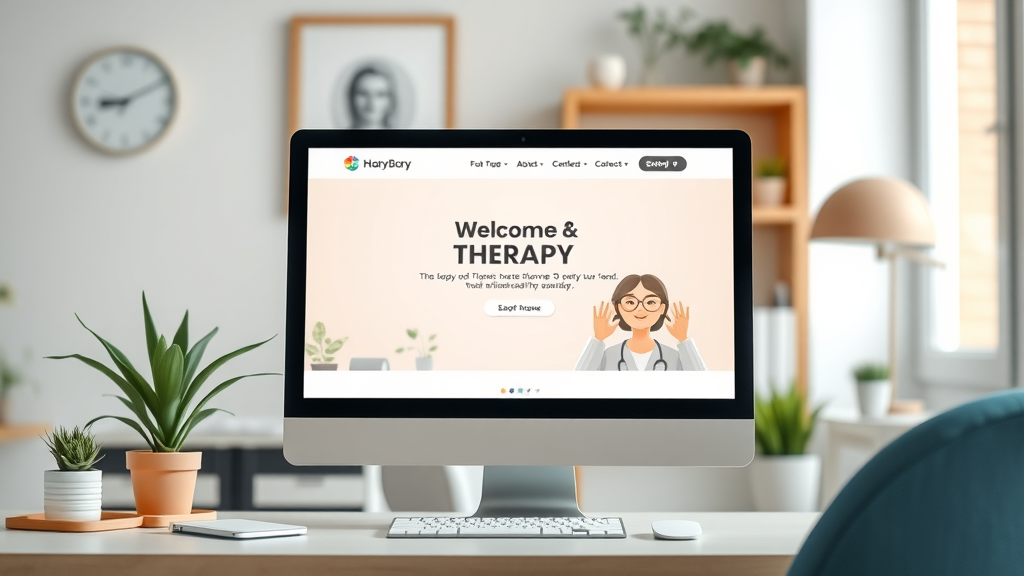Did you know that 97% of adults in the US turn to the internet for mental health information? As mental health needs rise and digital attention spans dwindle, online advertising for therapists is no longer just an option—it's a necessity. Yet, most therapists navigating the complex digital world make critical mistakes that drain budgets, limit growth, and leave potential clients in the dark. This guide reveals those costly errors and gives you proven ways to use digital marketing, content marketing, and paid ad strategies to grow your practice. Don't just survive—thrive, by mastering modern online advertising techniques tailored for therapy professionals.
Why Online Advertising for Therapists Is a Game Changer in Digital Marketing

- Did you know that 97% of adults in the US turn to the internet for mental health information? As the landscape of digital marketing continues to evolve, online advertising for therapists has become the cornerstone of an effective therapy practice. This section explores how digital marketing and online advertising for therapists have disrupted traditional outreach and why your therapy practice cannot afford to ignore this shift.
Online advertising for therapists has transformed how private practice owners connect with potential clients , provide therapy services, and build trust in a digital-first world. By harnessing the power of digital marketing platforms like Google Ads , Facebook Ads , and targeted content marketing, therapy professionals are no longer limited to word-of-mouth or local referrals. Instead, they're reaching people actively seeking mental health services, and who may have never considered therapy before encountering an engaging online ad or informative blog post.
In today's hyper-connected landscape, an effective online presence is essential for persistent growth. Digital marketing for therapists enhances search engine visibility, positions them as thought leaders, and enables continuous engagement through social media and blog content. Those who don't adapt risk being left behind in search results, missing out on a massive audience searching for support. Embracing online advertising and the shift to digital marketing is now vital for any therapist looking to grow your practice and make a lasting impact.
Key Lessons: Common Pitfalls in Online Advertising for Therapists
- The most frequent online advertising errors therapists make
- How to craft effective marketing for therapists
- Proven ways to grow your practice online
- Sustainable content marketing strategies for therapy practice
- How to optimize paid advertising for lasting impact
| Channel | Average Cost | Reach | Conversion Rate | Best For |
|---|---|---|---|---|
| Google Ads | High | Wide | 7-10% | Immediate outreach |
| Facebook Ads | Moderate | Wide | 4-7% | Targeted demographics |
| Instagram Ads | Moderate | Medium | 5-8% | Visual content sharing |
| LinkedIn Ads | High | Niche | 3-6% | B2B referrals |
| Content Marketing | Low | Long | 5-12% | Ongoing engagement |
"Online advertising for therapists is no longer optional—it's fundamental to maintaining a thriving private practice." - Industry Expert
Essential Components of Successful Online Advertising for Therapists
Crafting a Targeted Marketing Strategy for Therapy Practice
- Tips on assessing your therapy practice goals and audience
- Integrating social media marketing, content marketing, and paid advertising
- Balancing digital marketing tools to maximize reach

Developing a successful marketing strategy for your therapy practice starts with defining clear goals and understanding your target audience . Are you focused on increasing local awareness, expanding teletherapy, or establishing a thought leadership brand? Once your goals are set, leverage mental health data and market research to identify the needs and preferences of your ideal potential clients . This insight allows you to craft messages and select platforms—from Google Ads to niche mental health directories—that best target your specific audience, ensuring your efforts are focused and effective.
Integrating social media marketing and content marketing into your overall strategy helps you maximize your online presence and build trust with potential clients. Use paid advertising alongside organic outreach to amplify your message and reinforce your credibility. By balancing paid ad campaigns with consistent content creation and social engagement, you'll sustain visibility across the most relevant digital channels, setting the stage for practice growth and improved client outcomes.
Building a Compelling Online Presence
- Optimizing your therapy practice website for search engine visibility
- Utilizing mental health content to engage prospects
- Incorporating testimonials and case studies

Your online presence is often the first touchpoint between your therapy practice and a potential client. A professional, SEO-optimized website with clear calls to action is critical to appearing in relevant search results. Make sure every page is designed to help users easily find information, book appointments, or contact you for more details. Incorporating a blog with valuable mental health topics boosts your search engine visibility while demonstrating expertise, reassuring clients they're in capable hands.
Showcasing testimonials, case studies, and clinician bios aids in building trust and rapport even before the initial contact. Ensure your website loading speed, mobile responsiveness, and user experience meet modern standards. Engaging mental health content—like personal success stories and practical self-help tips—deepens your connection with visitors while reinforcing your value proposition as the mental health professional of choice for those seeking therapy services.
Leveraging Paid Advertising Without Wasting Your Budget
- How to set up effective Google Ads for mental health services
- Segmenting your audiences for social media platforms
- Tracking and measuring ROI from paid ad campaigns
Many therapists launch paid advertising campaigns without the strategic planning needed for success. For Google Ads , granular keyword targeting lets you capture people seeking “therapy near me,” “counseling for anxiety,” or mental health services in your area. Well-structured ad groups, negative keywords, and persuasive ad copy all improve campaign efficiency while minimizing wasted spend. Importantly, set a realistic budget and monitor metrics like conversion rate, cost per inquiry, and client acquisition cost to adjust campaigns for optimal ROI.
Paid advertising on social media platforms requires careful segmentation—not just by demographics, but also by interests, behaviors, and mental health needs. Tools on Facebook and Instagram let you test different audiences and messages, ensuring your ads appear only to those most likely to benefit. Tracking tools built into each media platform, combined with Google Analytics, allow you to see real performance, refine underperforming ads, and double down on strategies that drive real growth for your therapy practice.
Animated demonstration: How to structure a paid ad campaign for therapists
Top Mistakes to Avoid in Online Advertising for Therapists
Ignoring Digital Marketing Metrics and Results
- Common tracking failures in therapy practices
- Which KPIs matter for digital marketing and online advertising for therapists
- Solutions for ongoing performance improvement

Far too many therapy practices launch digital marketing and paid ad campaigns without tracking their performance. Failing to monitor leads, conversions, and return on investment can quickly exhaust your budget with little to show for it. Track key performance indicators (KPIs) like click-through rate, conversion rate, and booked appointments for every ad and platform used. Use analytic tools integrated with your website and ad platforms to identify what drives inquiries and what doesn’t so you can refine your marketing strategy in real-time.
Another common mistake is ignoring insights from campaign data. Regularly review metrics from Google Ads, social media marketing, and content marketing to adjust your budget, pause underperforming ads, and focus resources on what works. Performance tracking isn’t about proving success—it’s about continuous improvement, making sure every dollar spent grows your practice and delivers more value to those seeking your mental health services.
Overlooking the Power of Content Marketing for Therapists
- How valuable content drives growth for your practice
- SEO techniques for marketing for therapists
- Examples of high-performing therapist content
Some therapists invest heavily in paid advertising, overlooking the long-term value of consistent content marketing . Valuable, well-crafted content helps you build trust with new and returning website visitors, distinguish yourself in the mental health profession, and dramatically improve your search engine rankings. Google rewards quality mental health blogs, videos, and informational pages that genuinely answer questions and offer support, especially from trusted health professionals.
Use basic SEO techniques—like keyword-rich blog posts, optimized meta titles, and internal linking—to improve your visibility in local and national search results. Share patient-friendly guides on topics like anxiety management, telehealth tips, or “what to expect from therapy” to engage existing clients and attract new ones. The most successful therapy practice websites combine content marketing with expert testimonials, mental health resources, and interactive tools, providing ongoing value to their community.
Misunderstanding Your Audience's Needs
- How to use mental health data for more relevant ad targeting
- Avoiding generic ad copy
- Refining your private practice messaging
Generic advertising messages and poorly-targeted ads rarely connect with those who truly need therapy services. Using market research and anonymous mental health data, tailor your messaging for your ideal audience—whether it's teens struggling with anxiety, couples seeking counseling, or professionals managing workplace stress. Avoid one-size-fits-all ad copy; instead, speak to specific needs, concerns, and motivations. For example, mention teletherapy flexibility, experience with trauma therapy, or insurance acceptance to make your online advertising genuinely relevant.
Refining your messaging is a continuous process. Use feedback from inquiries, session notes (while maintaining privacy), and digital marketing analytics to evolve your ad copy, landing pages, and content offers. This client-centric approach ensures your private practice stands out as empathetic, effective, and uniquely qualified to provide mental health services.
Choosing the Wrong Platforms for Paid Advertising
- Which social media platforms and paid ad channels are best for mental health professionals
- Platform-specific strengths and pitfalls

Not every media platform delivers equal results for every therapy practice. Placing paid ads on irrelevant or low-traffic platforms wastes your time and money. For most therapists, Google Ads delivers the best immediate results by reaching those actively seeking therapy services, while Facebook and Instagram excel at targeted, visually-driven campaigns and retargeting for ongoing engagement. LinkedIn, while more expensive, is uniquely effective for B2B referrals and connections with other health professionals or corporate wellness programs.
Regularly audit your advertising mix to make sure your time and resources are directed toward the channels producing new client inquiries—don’t be lured by trendy apps or platforms unless your target audience is genuinely active there. Evaluate the reporting tools provided by each platform to accurately measure paid advertising effectiveness and avoid costly misallocation of your digital marketing spend.
Video walkthrough: Setting up your first Google Ads campaign for a therapy practice
Step-by-Step Plan: Effective Online Advertising for Therapists
- Clarify your online advertising goals
- Identify your ideal therapy clients using mental health market research
- Select optimal digital marketing and paid advertising platforms
- Craft compelling ad copy and visuals for mental health audiences
- Set and track advertising budgets
- Analyze and adjust campaigns for ongoing practice growth
People Also Ask About Online Advertising for Therapists
What is the best platform for advertising for therapists?
- For therapy practices, Google Ads and Facebook Ads are often most effective for immediate visibility and targeted reach. Each platform offers unique tools for digital marketing, paid ad segmentation, and content marketing that can foster sustained practice growth.
How do I advertise myself as a therapist?
- Start by building an optimized online presence, utilize content marketing to share expertise, and run paid advertising on platforms where your ideal clients seek mental health services. Personal branding is crucial for marketing for therapists and therapy practice success.

What is the best marketing for therapists?
- A blended marketing strategy incorporating digital marketing, social media marketing, Google Ads, content marketing, and community engagement will yield the best results for online advertising for therapists.
How to promote online counselling?
- Promote online counselling with targeted Google Ads, engaging social media marketing, and high-value mental health content that highlights the advantages and effectiveness of teletherapy in your therapy practice.

Proven Strategies to Grow Your Practice With Online Advertising
- How therapists are using paid advertising and digital marketing to drive new client inquiries
- Case studies of therapy practice growth via online presence and content marketing
Therapists nationwide are successfully leveraging paid advertising and digital marketing to increase inquiries, schedule more sessions, and solidify their reputation as local mental health leaders. For example, practices with strategic content marketing plans often see organic traffic and leads rise steadily month over month, while well-run Google Ads campaigns produce immediate spikes in qualified inquiries, especially for niche therapy services or specialties.
Many growing practices document their digital journey, sharing case studies of how revising ad copy, improving social media marketing, or refining website SEO resulted in measurable growth. These stories highlight the importance of ongoing adjustment, testing new platforms, and using both paid and organic approaches to maximize online presence and consistently grow your therapy practice.
Expert Recommendations: Marketing for Therapists—What Actually Works
- Industry tips for successful online advertising for therapists and mental health services
- Summary checklist for therapy practice campaigns that generate results
- Quote from a leading digital marketing strategist in healthcare

Based on extensive industry experience, successful online advertising for therapists involves:
- Setting clear, measurable objectives for every digital campaign
- Choosing the right blend of Google Ads, content marketing, and social media outreach
- Prioritizing ethical compliance and client privacy in every ad
- Regularly auditing campaign performance and pivoting when needed
- Continuously refining your website and messaging to reflect current best practices in mental health marketing
"The difference between thriving and surviving in private practice is often found in the quality of your online advertising." – Therapy Marketing Specialist
Explainer: Dos and Don'ts of Online Advertising for Therapists in Real-World Campaigns
Quick Reference FAQ: Online Advertising for Therapists
- What budget should a private practice allocate for paid advertising? Most experts recommend starting with 5-10% of monthly gross revenue for paid ad campaigns and adjusting up as ROI is demonstrated.
- Does content marketing help new therapists grow a practice? Yes, regularly published mental health content builds online presence and trust, helping even new practices attract and retain clients.
- How long does it take for digital marketing for therapists to show results? Expect several weeks to months for steady growth from content marketing, but some paid ads (like Google Ads) can drive inquiries almost immediately.
- Are there compliance risks when advertising mental health services online? Yes, therapists must consider HIPAA, advertising guidelines, and privacy protections to avoid legal pitfalls.
Avoiding Legal and Ethical Pitfalls in Digital Marketing for Therapy Practice
- Understanding advertising guidelines for mental health services
- HIPAA considerations in digital marketing and paid advertising for therapists
- Best practices for client confidentiality online
Advertising mental health services requires careful adherence to state and federal regulations. Always comply with HIPAA by never sharing identifiable client information and using secure forms for online inquiries. When marketing for therapists, ensure all claims are truthful, non-deceptive, and consistent with ethical mandates of your licensing board. Every piece of content, ad, and social post should respect client privacy and uphold the integrity of the health profession.
Checklist: Winning Online Advertising Strategies for Therapy Practice
- Review your digital marketing goals
- Regularly audit your social media and content marketing efforts
- Monitor paid ad performance and adjust as needed
- Protect client privacy in all outreach
- Grow your practice consistently with data-driven actions
Final Thoughts: Mastering Online Advertising for Therapists Without Costly Mistakes
- Your journey to effective digital marketing starts with a commitment to avoid the mistakes outlined above. Embrace the right mix of social media, paid advertising, and content marketing—then monitor, refine, and grow your practice for long-term success.
"The difference between thriving and surviving in private practice is often found in the quality of your online advertising." – Therapy Marketing Specialist
Take Your Therapy Practice to the Next Level With Digital Marketing
- Ready to grow your practice and attract more clients with online advertising for therapists? Discover the biggest & best traffic source for your business. This works for Amazon, Walmart, eBay & 1000s of local businesses— and will work for you too! https://theamplificator.clientcabin.com/app/info
 Add Row
Add Row  Add
Add 




Write A Comment